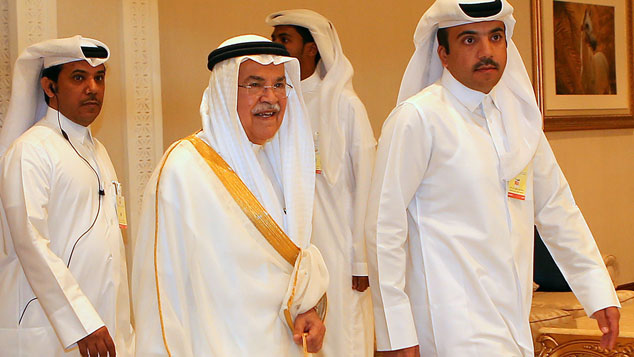
The oil price has plunged this morning, diving by as much as 7% at one point. Why?
There was a big gathering of the big oil producers in Doha this weekend, both those belonging to oil cartel Opec and non-cartel members such as Russia.
They were hoping to come to a deal to freeze production.
Long story short, they didn’t. Hence the fall.
But what happens now?
The great oil flop
Sunday’s meeting in Doha was attended by the major oil producers, including big non-Opec players such as Russia and Mexico. The goal was to establish the first global oil deal in 15 years. Any such deal would have covered nearly half of global crude oil production.
They didn’t manage to do it.
The sticking point seems to come down to friction between Saudi Arabia and Iran. The Iranians have no desire to freeze their oil production, because they’ve only just started being able to export fully again after years under sanctions. That’s understandable. But at the same time, the Saudis don’t want to sign up for any deal that effectively involves them giving up precious market share to Iran.
There are plenty of theories about what made the talks breakdown. The FT reports that, on one hand, the Saudis had been hoping that Iran might offer “to cap production at a later date”. But Russia’s oil minister argues that the Saudis were to blame, for changing their minds at the last minute.
On the one hand, reformers in Saudi Arabia want to reduce the country’s dependence on oil. On the other, there’s the fact that the Saudis are also keenly aware that they are no longer the “swing” producer in the oil market, and that the only way to maintain their power and market share is to make it too unprofitable for US shale producers to pump out oil.
That strategy has worked to an extent – ever more oil companies in the US are going bust, and rig counts keep falling – but it has taken a lot longer than anyone had expected.
What does this mean for global markets?
So how significant is this? It’s worth remembering that a production freeze at this level would hardly be a major restriction on supplies – most countries are producing at near-record levels anyway.
Also, all of these countries would cheat on their quotas anyway – you can take that as a given. So beyond marking some imaginary line in the sand, it wouldn’t have had a huge practical impact.
Meanwhile, since mid-January’s low point, the price of crude (depending on which measure you use) has risen from the $30 a barrel mark to over $40.
Can that continue? This certainly throws a spanner in the works. And there’s no doubt that oil production remains high, along with supplies. (You can read more on this in our recent MoneyWeek story on the issue – if you’re not already a subscriber, sign up here).
I still suspect that we’ve seen the bottom for oil already. But this could knock the wind out of the sails of the recovery for the moment.
As for the knock-on effect on global markets – those have been behaving somewhat oddly on the oil front. They go up when oil goes up, and down when oil goes down.
Once upon a time, falling oil prices were seen as a good thing. A drop in the price of raw materials was good news for consumers of oil, which is most of the developed world.
What’s changed?
It’s hard to say exactly. I’m going to get a little abstract here, but bear with me. When money and investment flow in one direction for a prolonged period of time, then markets get used to it. Structures and ways of doing things grow up around those money flows, like algae, even if the underlying investment is not particularly sound or healthy.
This – more than fears over producer solvency or even deflation – probably explains the real problem. The financial world has grown used to an ever-increasing oil price. That’s created its own little eco-system, as a river of money has flowed consistently in one direction for a long time.
That flow is changing now. And change is painful, even if it’s a healthy change. That whole ecosystem is being disrupted by the shift in the tides.
Being more explicit, the world is going to have to get used to an oil price that’s a lot lower than it had planned for. And that means that various parts of that ecosystem are going to be wiped out.
We still haven’t seen the sorts of big, headline-grabbing casualties you’d expect from a blow-out like this. Expect to see them before this is all over.